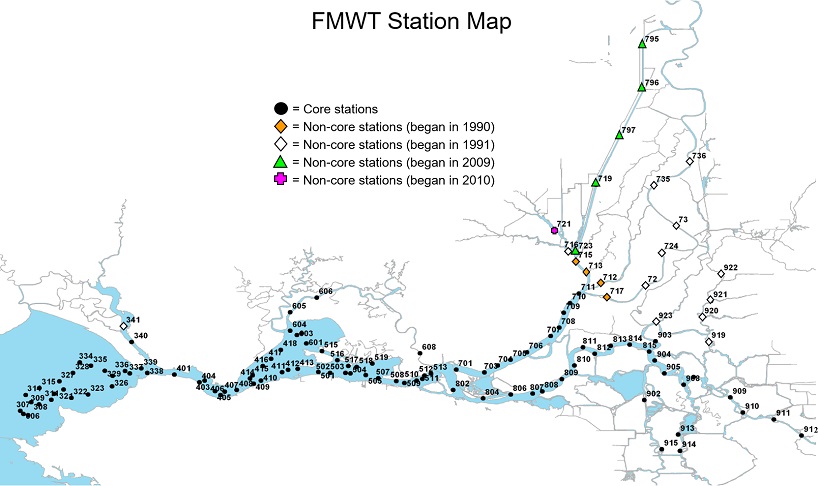Program Overview
The Fall Midwater Trawl Survey (FMWT) has sampled annually since its inception in 1967, with the exceptions of 1974 and 1979, when sampling was not conducted. The FMWT was initiated to determine the relative abundance and distribution of age-0 striped bass (Morone saxatilis) in the estuary, but the data has also been used for other upper estuary pelagic species, including Delta Smelt (Hypomesus transpacificus), Longfin Smelt (Spirinchus thaleichthys), American Shad (Alosa sapidissima), Splittail (Pogonichthys macrolepidotus), and Threadfin Shad (Dorosoma petenense).
The FMWT samples 122 stations each month from September to December and a subset of these data is used to calculate an annual abundance index. These 122 stations range from San Pablo Bay upstream to Stockton on the San Joaquin River, Hood on the Sacramento River, and the Sacramento Deep Water Ship Channel. Sampling takes approximately 10 days per month to complete. Historically, FMWT sampling occasionally began as early as July (1972) or August (1968-1973, 1993-1994, 1996-1997) and sometimes continued past December to March (1968-1973, 1978, 1991-2001) or beyond (1992-1995). The consistent January-March midwater trawl sampling conducted from 1991-2001 to track movements of mature adult delta smelt was replaced in 2002 with the more effective Spring Kodiak Trawl.
 Map of the current FMWT Stations. CDFW image.
Map of the current FMWT Stations. CDFW image.
(click to enlarge in new window)
History
- 1967: Start of the Fall Midwater Trawl Survey
- 1990: Addition of upper Sacramento River and Steamboat slough stations
- 1991: Addition of Liberty Slough and Napa River stations
- 2009: Addition of Sacramento River Deepwater Ship Channel stations
- 2010: Addition of Cache slough station
- 2011: Zooplankton data collected from this point forward at 32 stations